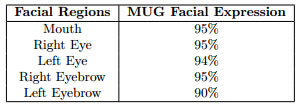This work proposes a method for the detection of 19 facial points of interest (landmarks). Most methods available in the art for detecting facial points fall into two main categories: global and local. Global methods are usually able to detect various landmarks simultaneously with robustness while local landmarks can often detect more quickly. The method presented is based on local information and is composed of several stages of processing to the detection of landmarks that describe eyes, eyebrows and mouth. The experimental results demonstrate that the proposed method compared to the results showed technical ASM compatible.
1. Face and Facial Regions Detection
Firstly, the face detection is performed with the traditional Viola–Jones object detection framework. The Viola-Jones framework consists of Haar-like features extraction method and Adaboost classifier. After face detection, the same Viola-Jones framework is used to detect the facial regions (e.g. eyes, mouth, ...). The eyebrows region was estimated from the eye region position.
Evaluation of the proposed system using MUG Facial Expression database
2. Facial Landmarks Extraction
After facial regions detection, several image processing methods (e.g. histogram equalization, thresholding, color conversion, morphological operations, ...) are used to extract 20 facial landmarks.
Facial Landmarks extracted from MUG Facial Expression database
3. Experimental Results
In this work, the Procrustes distance is used to evaluate the precision of the extracted landmarks between image annotations. This method is commonly used to compare the shape of two or more objects (i.e. their similarities). The shape of each face is defined by a set of 20 facial landmarks. Table 1 shows the similarity rate of the extracted landmarks in each facial region.
Table 1: Similarity rate of facial regions.

The figures below show the cumulative distribution of landmarks similarity between image annotations. The proposed method is compared with the ASM method. As can be seen, the proposed method obtained inferior results in mouth and eyes, but better results in eyebrows.





4. Publication
2012 - Silva, Caroline; Schnitman, Leizer ; Oliveira, Luciano. "Detection of Facial Landmarks Using Local-Based Information". The 19th edition of the Brazilian Conference on Automation - CBA 2012, Campina Grande, PB, Brazil (oral presentation), September 3, 2012. [PDF] [PRESENTATION]
5. Source Code